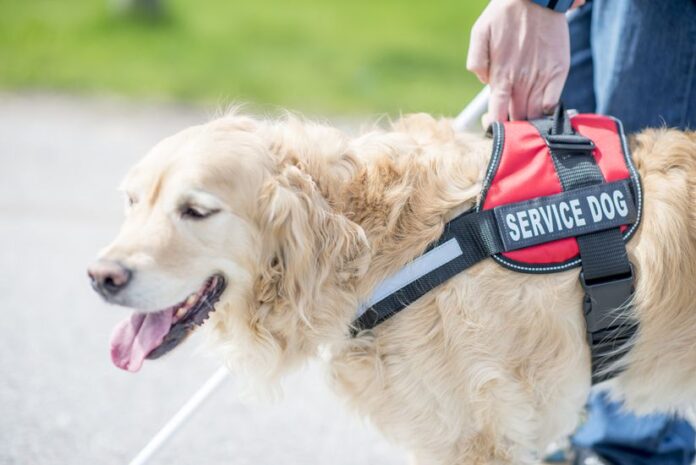Service dogs are extraordinary animals that play a crucial role in the lives of many individuals.
They are offering more than just companionship. These specially trained dogs provide invaluable assistance to people with disabilities, enabling them to lead more independent and fulfilling lives. In this article, we’ll explore how service dogs help, the different types of service dogs. The process of getting one, and important things to consider if you’re thinking about adding a service dog to your life.
How Service Dogs Help
Service dogs are trained to perform specific tasks that mitigate the effects of a disability. Their roles can vary widely depending on the needs of their handlers. Here are some of the key ways service dogs can help:
- Mobility Assistance: Service dogs can assist people with physical disabilities by helping them balance, retrieving dropped items, opening doors, or even pulling wheelchairs. For those with limited mobility, these dogs provide essential support, making daily tasks more manageable.
- Guide Dogs: Guide dogs are perhaps the most well-known type of service dog. They assist individuals with visual impairments by leading them around obstacles, stopping at curbs, and helping them navigate their environment safely.
- Hearing Dogs: These dogs are trained to alert people with hearing impairments to important sounds such as doorbells, alarms, or the presence of others. They can help their handlers stay aware of their surroundings and avoid potential dangers.
- Medical Alert Dogs: These dogs are trained to detect specific medical conditions, such as seizures, diabetes, or severe allergies. For example, a seizure alert dog can recognize the signs of an impending seizure and warn their handler, giving them time to find a safe place or take preventive measures.
- Psychiatric Service Dogs: These dogs provide support to individuals with mental health conditions, such as PTSD, anxiety, or depression. They can be trained to perform tasks like interrupting harmful behaviors, providing deep pressure therapy, or reminding their handler to take medication.
- Autism Support Dogs: For individuals on the autism spectrum, service dogs can help with sensory processing, provide a calming presence, and improve social interactions. These dogs often serve as a bridge between their handler and the outside world, reducing anxiety and increasing confidence.
Types of Service Dogs
There are several types of service dogs, each trained to assist with different needs:
- Guide Dogs: For individuals with visual impairments.
- Hearing Dogs: For those with hearing impairments.
- Mobility Assistance Dogs: For people with physical disabilities.
- Medical Alert Dogs: For individuals with conditions like epilepsy or diabetes.
- Psychiatric Service Dogs: For people with mental health conditions.
- Autism Support Dogs: For those on the autism spectrum.
Each type of service dog undergoes specialized training tailored to the specific needs of their handler.
How to Get a Service Dog
Acquiring a service dog is a significant commitment and involves several steps:
- Assessment: The first step is to determine whether a service dog is the right fit for your needs. This often involves consultations with healthcare providers, trainers, and service dog organizations.
- Application Process: Once it’s determined that a service dog is appropriate, you’ll need to apply through a reputable service dog organization. The application process typically includes providing medical documentation and undergoing an interview to assess your needs.
- Training: Service dogs undergo rigorous training, which can take up to two years. The training includes basic obedience, socialization, and task-specific skills. Some organizations also offer training for handlers to ensure they know how to work effectively with their service dog.
- Matching: After training, the organization will match the dog with a handler based on compatibility and the specific tasks the dog has been trained to perform.
- Ongoing Support: Once you have your service dog, you’ll need to continue training and maintain the dog’s skills. Many organizations offer ongoing support and resources to help you and your dog succeed.
What You Need to Know
- Legal Rights: Service dogs are protected under various laws, including the Americans with Disabilities Act (ADA). This means they are allowed to accompany their handlers in public places where pets are typically not allowed, such as restaurants, stores, and public transportation.
- Responsibilities: Owning a service dog comes with responsibilities. Regular veterinary care, proper training, and ensuring the dog’s well-being are essential. Additionally, handlers must understand how to manage and work with their service dog effectively.
- Costs: They can be expensive due to the extensive training they require. While some organizations provide dogs at no cost to the handler, others may charge fees. There are also ongoing expenses for food, healthcare, and other necessities.
- Misrepresentation: It’s important to note that not all dogs are service dogs. Misrepresenting a pet as a service dog can harm the reputation of legitimate service dog teams and lead to stricter regulations. Service dogs must be well-behaved, well-trained, and perform specific tasks related to their handler’s disability.
- Public Interaction: While service dogs are often seen in public, it’s essential to remember that they are working animals. Distractions can interfere with their ability to assist their handler, so it’s best to avoid petting or interacting with a service dog without the handler’s permission.
Conclusion
Service dogs are invaluable partners for individuals with disabilities, providing them with the support they need to lead more independent lives. Understanding how these dogs help, the process of getting one, and the responsibilities involved is crucial for anyone considering a service dog. By respecting the work these animals do and the bond they share with their handlers, we can help create a more inclusive and supportive environment for all.











